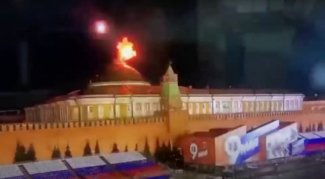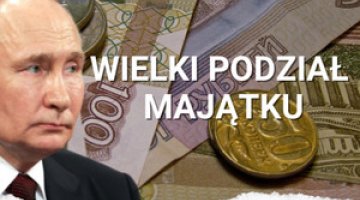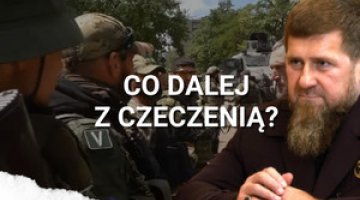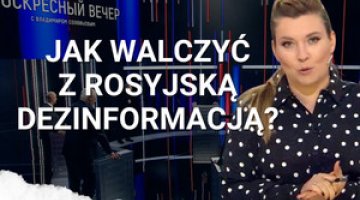Drones over the Kremlin. Day 435 of the war

In the early hours of 3 May, two drones exploded over the Kremlin. One of them caused a fire on the dome of the Senate Palace, where a flagpole bearing the state flag was installed. The Russian authorities refrained from commenting on the incident until the afternoon. President Vladimir Putin’s spokesman Dmitri Peskov accused the “Kiev regime” of carrying out the attack, and stated that the drones had been destroyed by ground combat systems. He added that the Russian government is treating the incident as a terrorist act and an attempt on the life of the head of state. He warned that Russia reserves the right to retaliate wherever and whenever it sees fit. State Duma Chairman Vyacheslav Volodin stated that the terrorist act targeting the president was an attack on all of Russia, and said the “Nazi regime” in Kyiv should be recognised as a terrorist organisation. He stressed that the incident precluded any peace negotiations. Deputy Secretary of the Russian Security Council Dmitri Medvedev called for the “physical elimination” of Ukrainian President Volodymyr Zelensky and his entourage. Towards the end of the day, a new theme emerged in the Russian narrative. Peskov named Washington as the initiator of the attack, and warned that such an action is “dangerous”, as it implied direct participation in the conflict. Russia’s deputy foreign minister Sergei Ryabkov said that relations between the Russian Federation and the United States were “on the brink of open armed conflict”: at the same time he insisted that “Moscow is trying to ensure that this does come about”.
The Ukrainian president denied that his country’s forces had been involved in the attack on the Kremlin. He noted that Putin wanted to accuse Ukraine of “crimes” in order to maintain the Russian public’s acceptance for the war. Mykhailo Podolak, an advisor to the head of the Presidential Office, called the drone attack a Russian provocation which signals that Moscow is preparing a large-scale terrorist act. He stressed that Ukraine is fighting a defensive war, and that attacks deep inside Russia would not affect the situation on the frontline. He pointed out that the Kremlin’s narrative is intended to justify further attacks on civilians.
Russian forces are continuing their assault in the western part of Bakhmut. According to Yevgeny Prigozhin, the units of his Wagner Group operating there have not received support (mainly ammunition supplies) from the regular formations of the Russian Armed Forces since early May, compounding the attackers’ losses. On 4 May, Prigozhin blamed defence minister Sergei Shoigu and Chief of General Staff General Valery Gerasimov directly for this state of affairs, and the next day he announced that on 10 May Wagner Group troops would withdraw from Bakhmut, handing the occupied positions over to Russian Army subunits.
Reports from the Ukrainian General Staff indicate that the Russians have crossed the Donets-Donbas canal northwest of Bakhmut. The invading troops were repulsed around the village of Markove, located halfway between Bakhmut and Kramatorsk (about 15 kilometres as the crow flies from both towns). Russian operations have been facilitated by the fact that in the area in question the Donets-Donbas canal runs largely under the surface, so it does not pose an obstacle to traversing the terrain. In the Bakhmut area, Russian forces also renewed attacks northeast of the key junction at Chasiv Yar, and in the area of Predtechyne village on the south-eastern outskirts of Kostiantynivka.
The intensity of the fighting east of Siversk has increased. Russian forces there are attempting to push the Ukrainian defenders out of Bilohorivka, which is the last village remaining under Ukrainian control in this area of Luhansk oblast. Russia’s further attempts to launch assaults in and south of Marinka, as well as attacks on Niu-York west of Horlivka (which has so far not been the target of direct attacks), appear to have failed.. Meanwhile on 4 May, for the first time in several months, the invaders’ troops refrained from undertaking any offensive operations in the Avdiivka area. According to the Ukrainian General Staff, however, the total number of Russian attacks that day revived to about 60 (from the level of about 40 to which it fell on 2–3 May). Representatives of the occupation administration, in turn, reported that Ukrainian forces were making attempts to reconnoitre by fire and to break through the Russian defences between Siversk and Kreminna, in the Vuhledar region, and south of Orikhiv in Zaporizhzhia oblast.
The Russians have carried out further attacks using Iranian-made Shahed-136/131 kamikaze drones. According to the Ukrainian Air Force Command (AFC), on 3 May the defenders shot down 21 out of 26, and on 4 May 18 out of 24 attack drones. Kyiv’s defences claimed a one hundred percent kill rate, although shrapnel damage and fires occurred in and around the city. On 3 May, Russian drones destroyed fuel infrastructure facilities in Kropyvnytskyi and unspecified targets (most likely military facilities) in Zaporizhzhia, Dnipro and Kostiantynivka, while on 4 May they destroyed targets in and around Odesa. According to AFC spokesman Colonel Yuri Ihnat, the Russian drone attacks are primarily intended to deplete Ukrainian air defences. The Russians are aware of their vulnerability to being shot down (the defenders are said to destroy around 80% the attacking drones), but they use them to detect the positions of air defence systems and exhaust the Ukrainian side’s ammunition supplies. According to Russian reports, the Ukrainian side has also launched at least two drone attacks, targeting fuel infrastructure facilities in Krasnodar Krai and Rostov oblast, as well as the Seshcha airport in Bryansk oblast (pro-Ukrainian guerrillas reported that two An-124 transport aircraft had been damaged there).
Russian forces continued to launch missile attacks at the Ukrainian forces’ immediate rear. For three consecutive days, missiles from S-300 systems fell on Zaporizhzhia. On 4 May, they also struck Kramatorsk; the Russians launched a total of 10 missiles against both cities on that day. Russian artillery and aviation continued to fire on and bombard the contact lines and in border areas. Outside the combat areas, Russian shelling of the right-bank part of the Kherson oblast (around 500 shells per day) and the Nikopol Raion in Dnipropetrovsk oblast has increased once more. As a result of the hostile shelling on 3 May, 24 people were reported killed and 46 wounded in Kherson and its vicinity, the highest civilian casualties in the area for several months. Energy infrastructure remains a principal target of Russian attacks in the frontline areas.
On 3 May, the United States announced another military aid package for Ukraine, the 37th, worth $300 million. It consists of additional missiles for HIMARS launchers, 155-mm artillery ammunition and 120-mm, 81-mm and 60-mm mortar grenades, TOW anti-tank guided missiles, AT-4 and Carl-Gustaf anti-tank grenade launchers, and 70mm Hydra-70 unguided air-to-ground missiles. For the first time in several months, the Americans will also hand over new 155-mm howitzers to Ukraine, but the number was not disclosed. A day earlier, Denmark’s parliament voted through a new military support package worth $250 million (1.7 billion Danish crowns), which will include (unspecified) munitions, demining equipment, pontoon bridges and air defence funding.
On 3 May, the Committee of Permanent Representatives of the Governments of the Member States to the EU (COREPER) agreed to allocate €1 billion to purchase ammunition for Ukraine from the European Peace Facility (EPF). On the same day, Ukraine’s prime minister Denys Shmyhal recalled that the EU had decided back in March to transfer €2 billion worth of ammunition to Ukraine.
Military support for Ukraine was one of the main topics of President Zelensky’s visits to Finland on 3 May (where he also met the prime ministers of Denmark, Iceland, Norway and Sweden) and the Netherlands on 4 May (where the heads of government of the Netherlands and Belgium held talks with him). During these talks he called for increased and accelerated deliveries of heavy armaments, as well as the transfer of combat aircraft to Ukraine. During his visit to Helsinki, he highlighted the correlation between the arms delivered to Ukraine so far and their successes on the front, in which the latter are conditioned by the former. He also stated that the Ukrainians were about to carry out a successful counteroffensive, after which they would certainly be given F-16 aircraft. The leaders hosting the Ukrainian president did not make any commitments to provide Ukraine with aircraft. The president of Finland made any possible handover of the F-18s used by his country conditional on the delivery of F-35s to replace them; for his part, the Dutch prime minister said that the delivery of F-16s “is a very sensitive topic” on which the Dutch are working with their partners. Denmark’s prime minister spoke in a similar vein. The Belgian prime minister said a new military support package would be announced soon, but did not give any details.
On 3 May, Ukraine’s deputy prime minister for European and Euro-Atlantic integration Olha Stefanishina expressed the hope that the NATO-Ukraine Council formula would be changed to a 32-nation format (instead of the current 31+1) at the NATO summit in Vilnius in July. This would emphasise that Ukraine is a unique partner of the Alliance, and not merely another supplicant. As she put it, Kyiv sees the Council as a platform to prepare and discuss decisions for the next NATO summit in Washington, which will take place on the 75th anniversary of the Alliance’s foundation. On 4 May, during his meeting with the prime ministers of the Netherlands and Belgium, the Ukrainian president said he was aware that his country would not join NATO during the war, but hoped that Kyiv would receive a signal from the allies during the Vilnius summit about the foreseeable prospect of accession.
While in the Hague, President Zelensky criticised the idea of a hybrid special tribunal to investigate Russia’s crimes in Ukraine. The concept calls for the establishment of a court that would operate under Ukrainian law and within Ukrainian jurisdiction while allowing the participation of judges and prosecutors from the International Criminal Court. Zelensky called for the creation of a special international court for the crimes of aggression committed by Russia, along the lines of the Nuremberg Tribunal.
The US Director of National Intelligence Avril Haynes said on 4 May that Russia is unlikely to be able to mount a significant offensive in Ukraine this year due to a shortage of ammunition and troops. She added that all indications are that Putin has scaled back his short-term ambitions in Ukraine, and intends to claim victory by “consolidating control over the occupied territory in eastern and southern Ukraine and ensuring that Ukraine never becomes a member of NATO”. Haynes also noted that Russian forces are preparing “new defensive positions” ahead of a Ukrainian counteroffensive, and that they had “captured less territory in April than in any of the previous three months”.
On 3 May, Ukrainian authorities warned that Russian forces were preparing a ‘false flag’ provocation. To this end, more than 300 soldiers have been selected from the assault troops of the 1st Armoured Army in Bryansk and Kursk oblasts. These men, wearing Ukrainian uniforms, may carry out provocations designed to discredit the Ukrainian army, such as acts of terrorism or simulated hostage-taking among the civilian population.
The deputy head of Ukraine’s defence ministry Hanna Malar stated that because the Russian authorities cannot enforce full obedience in the occupied territories, they are importing organised crime groups under their control to the area. These groups form militias which provoke conflicts in public places with people expressing anti-Russian views; local law enforcement authorities then blame those attacked for the incidents.
On 3 May, the Security Service of Ukraine, with the support of the police, took down bot farms in nine oblasts that had been spreading false reports disparaging the Ukrainian authorities and issuing false alerts stating that public facilities had been mined and that “terrorist attacks” have been planned. The criminals created anonymous social media accounts that were followed by more than 200,000 users.
On 3 May Oleksiy Danilov, Secretary of the National Security and Defence Council, referred to the restoration of war allowances of 30,000 hryvnias (around €750) for all those serving in the military; he said that this solution is unfair, and equates the status of soldiers at the front with that of those serving deep in the rear. The finance ministry said that the war allowances can only be reinstated if the tax burden is raised. According to finance minister Serhiy Marchenko, the military incentive system should be set up by the General Staff and the defence ministry, and any decision by parliament to raise military spending should be thought through very carefully. The criticism refers to the law of 10 April, which restored the favourable financial arrangements to all mobilised personnel.
On 4 May, the Ukrainian defence ministry announced that at the request of the Armed Forces of Ukraine, proposals have been drafted for legislation to lower the age of those called up for basic military service (from 27 to 25). Since regular conscription is suspended during martial law, it is impossible to send those normally covered by it to the front. Lowering the age would allow citizens between the ages of 25 and 27 to be subject to mobilisation.
Commentary
- The Russian government’s reaction to the air strike targeting the Kremlin’s ‘No. 1 state facility’ (located in the strict protection zone covered by the Federal Protection Service and the military) indicates that the idea that the incident was staged cannot be ruled out. For the time being, however, it has become a pretext for another escalation of Russia’s war rhetoric. The absurd statement that it was an assassination attempt on Putin – when at the same time it was reported that he was not in the Kremlin at the time – is meant to emphasise that Russia has become the object of direct aggression from not only Ukraine, but also the US. Hitting the dome of the Senate Palace, where the flag of Russia flies, symbolised an attack on the entire country. Internationally, Moscow has used the incident to reject any peace talks with Ukraine as long as the country is led by President Zelensky. The stepped-up rhetoric, which included another threat to use nuclear weapons, represents the latest attempt to pressure the US and European countries to revise their support for Ukraine. The narrative is also an attempt to convince those countries which maintain contacts with the Kremlin that Russia is not the aggressor. Domestically, the propaganda is intended to convince the Russian public of the existential nature of the war, in which Russia has become the target of a US attack.
- Russian forces are making small advances in Bakhmut and its vicinity practically every day. However, in other combat zones, it has been possible to observe a relative balance between the attackers and defenders for the past several weeks (in Avdiivka and Marinka) or even months (Vuhledar, Siversk, Kreminna, the border of Luhansk and Kharkiv oblasts, Kupiansk). This has not allowed the Russians to achieve any real successes, or the Ukrainians to push the attackers back. In the last few days there have been ever more cases of both sides probing the enemy’s defences and looking for weak points. On the Russian side, this involves renewed attempts to assault positions that have not been attacked for several weeks, or attempts to break through defences in areas which had not previously been attacked. On the Ukrainian side, reconnaissance by fire is being carried out in the same areas (especially in Zaporizhzhia oblast) which are seen as potential strike directions as part of the announced counteroffensive.





